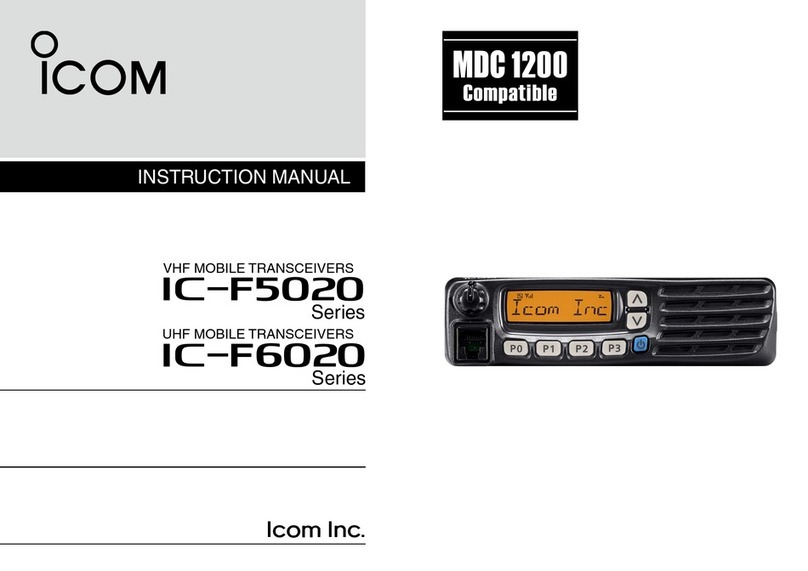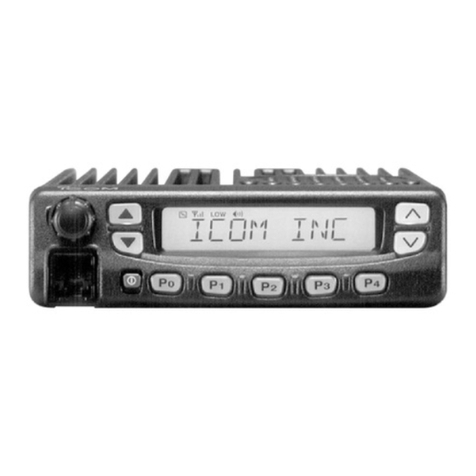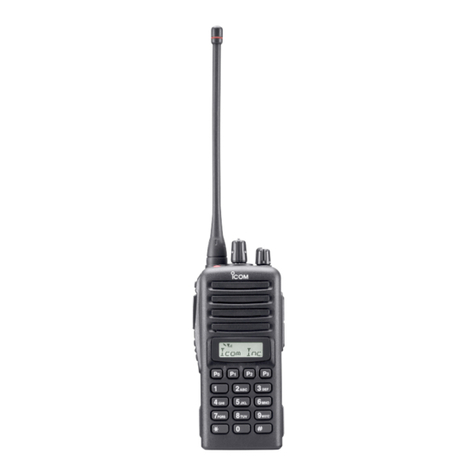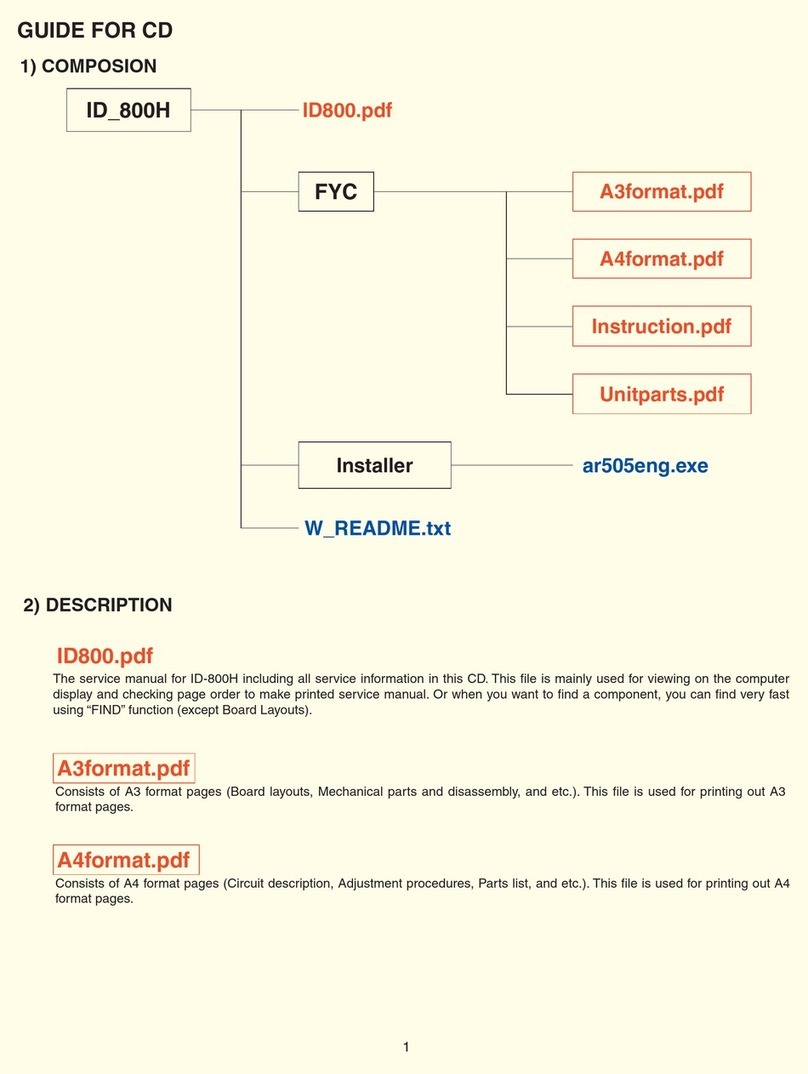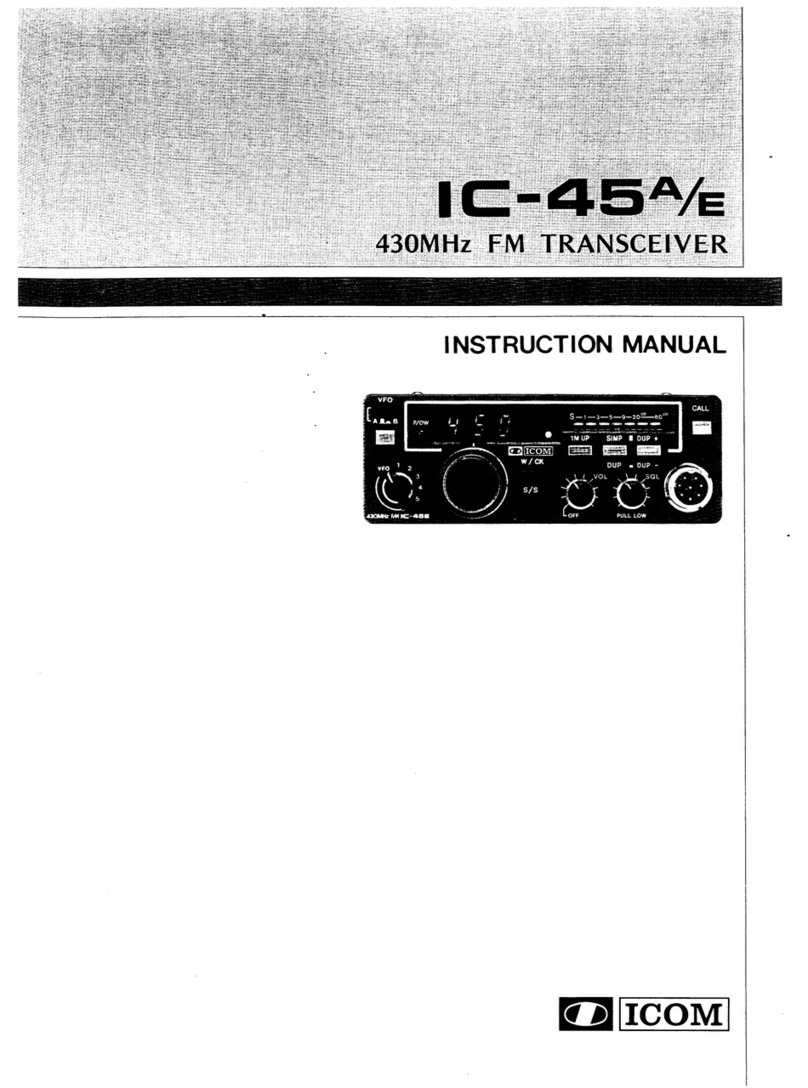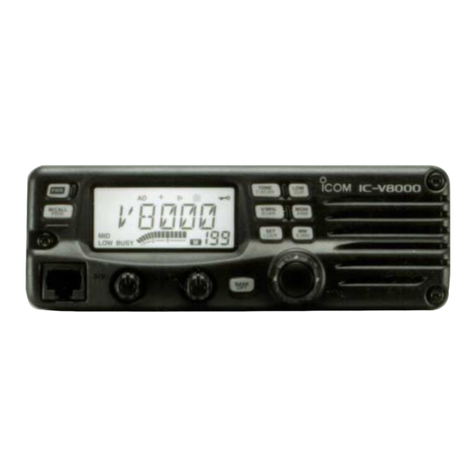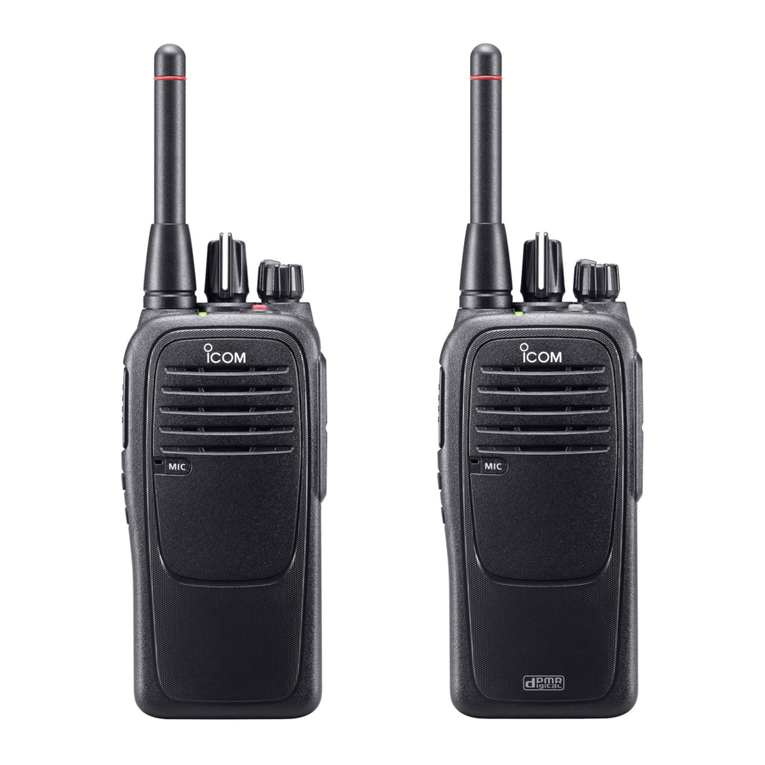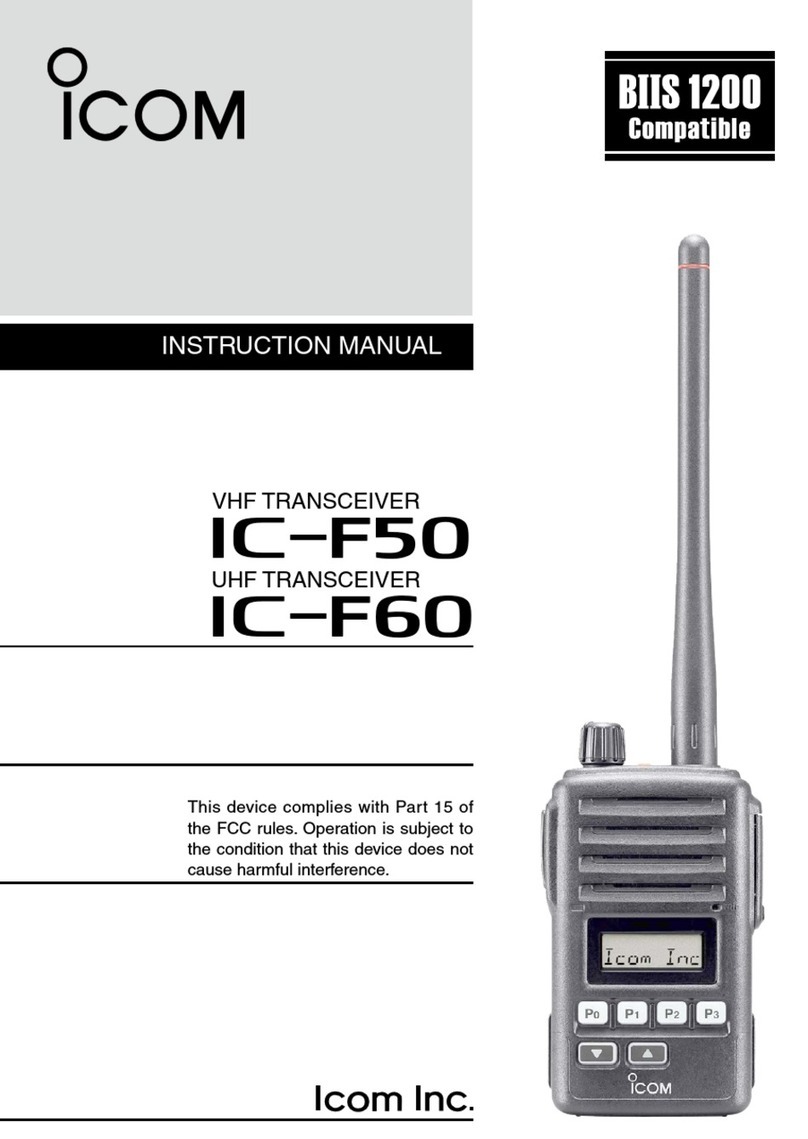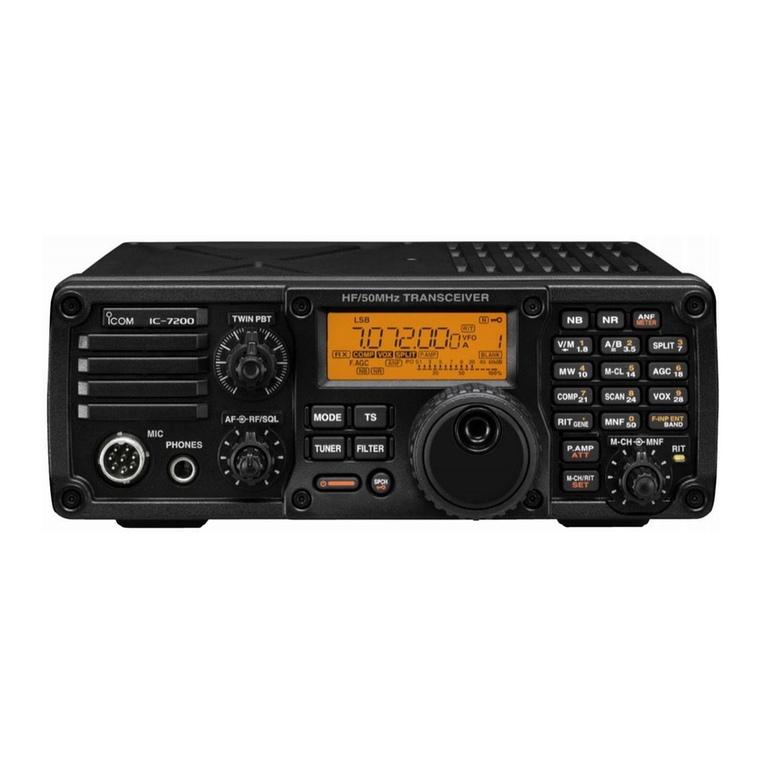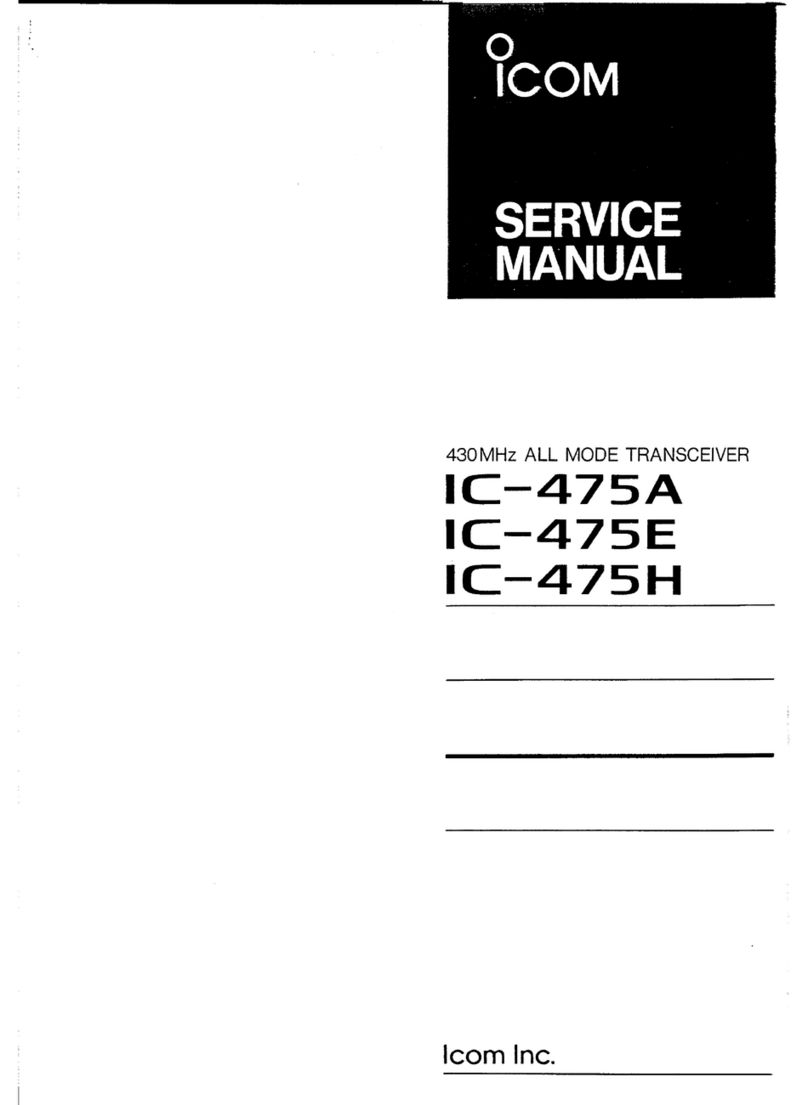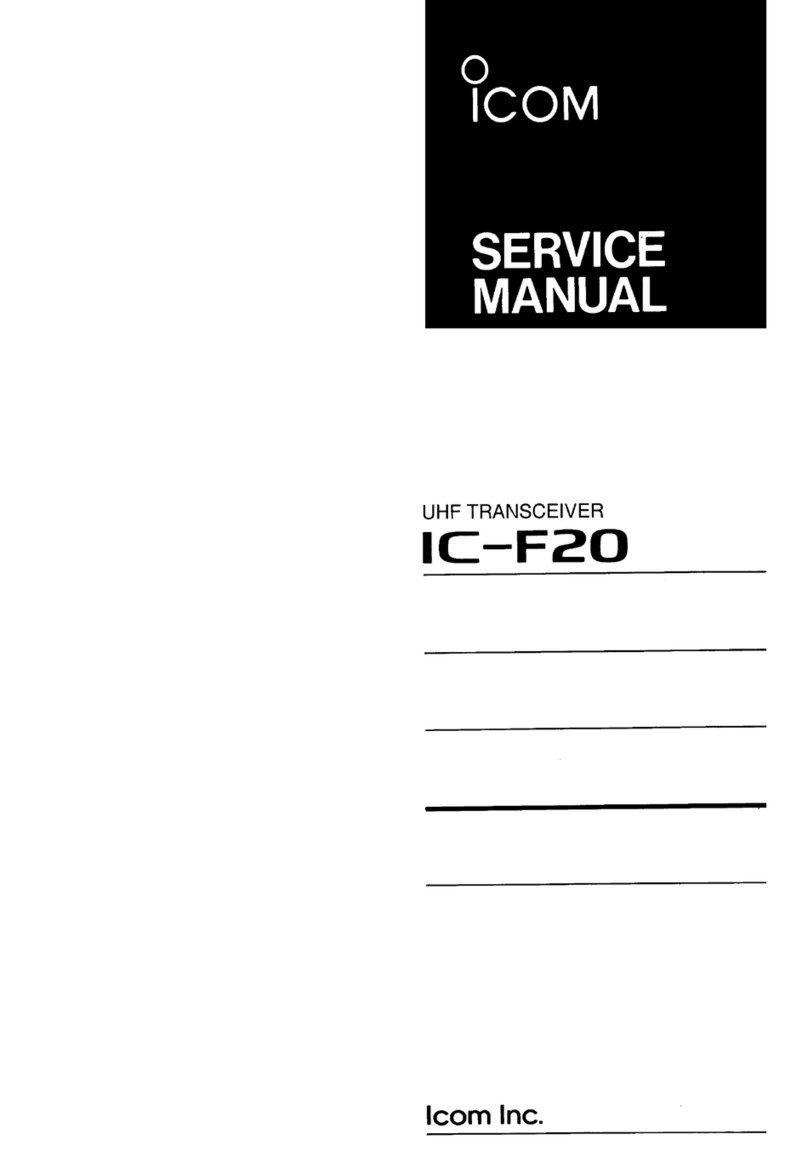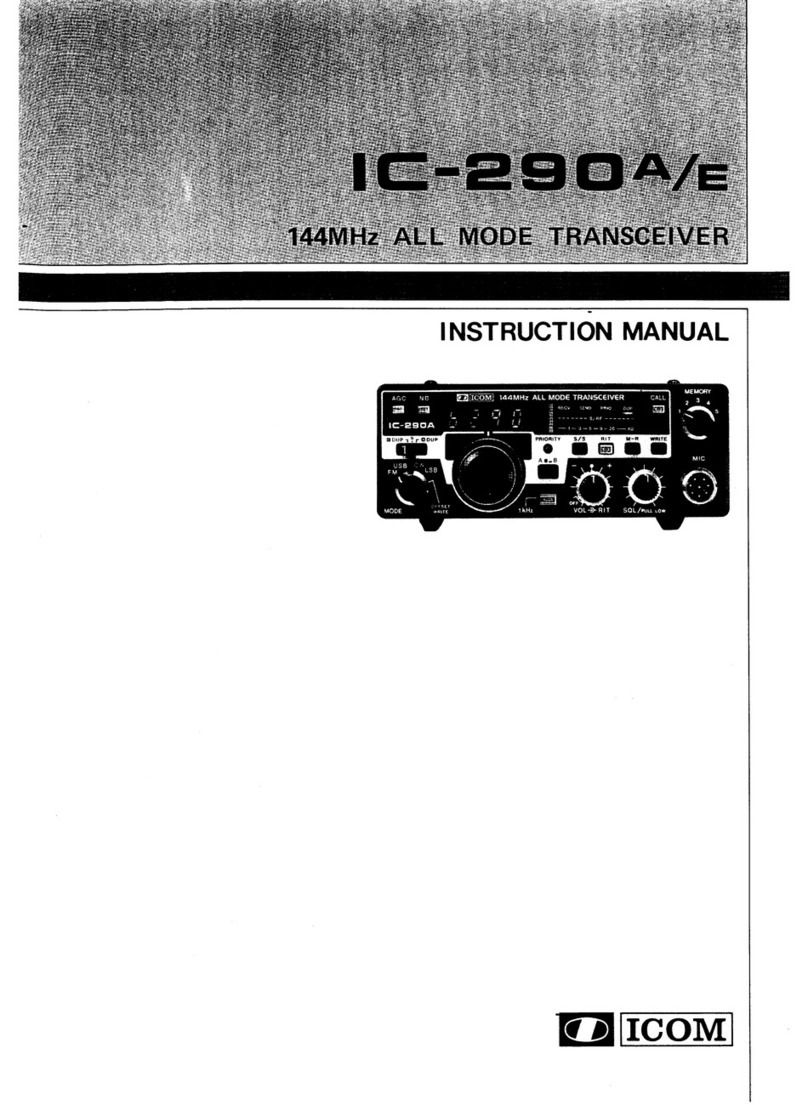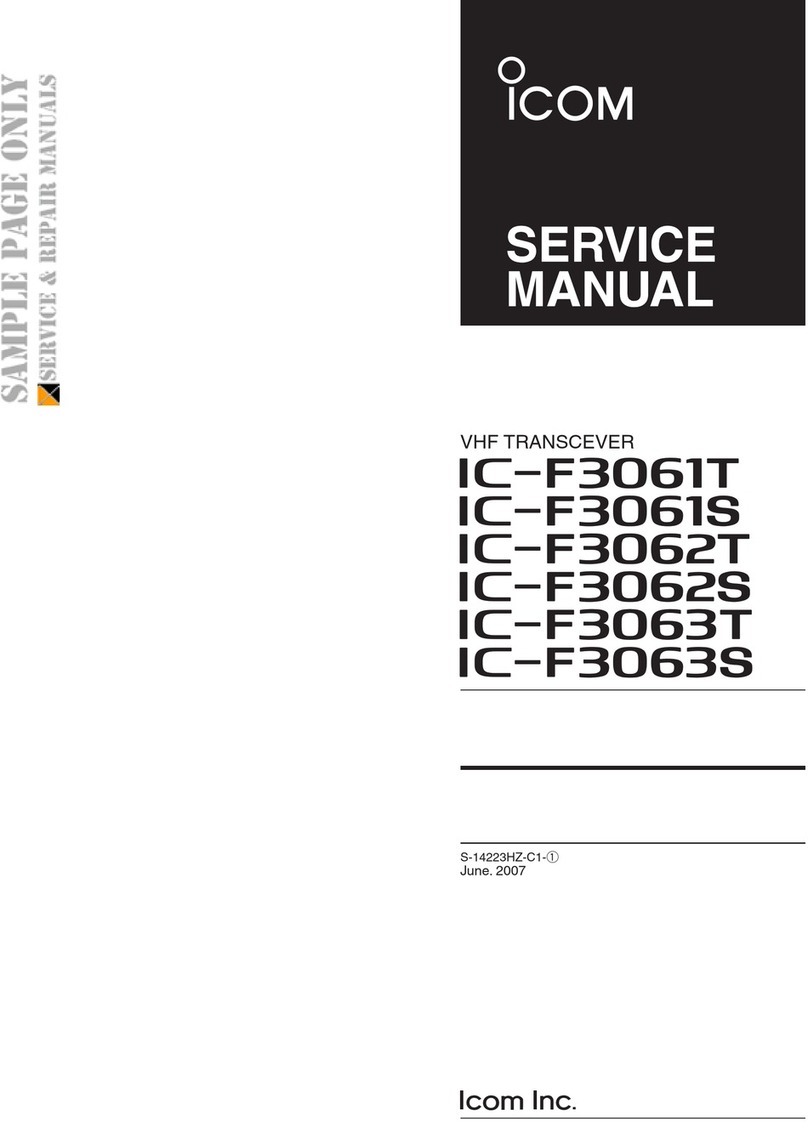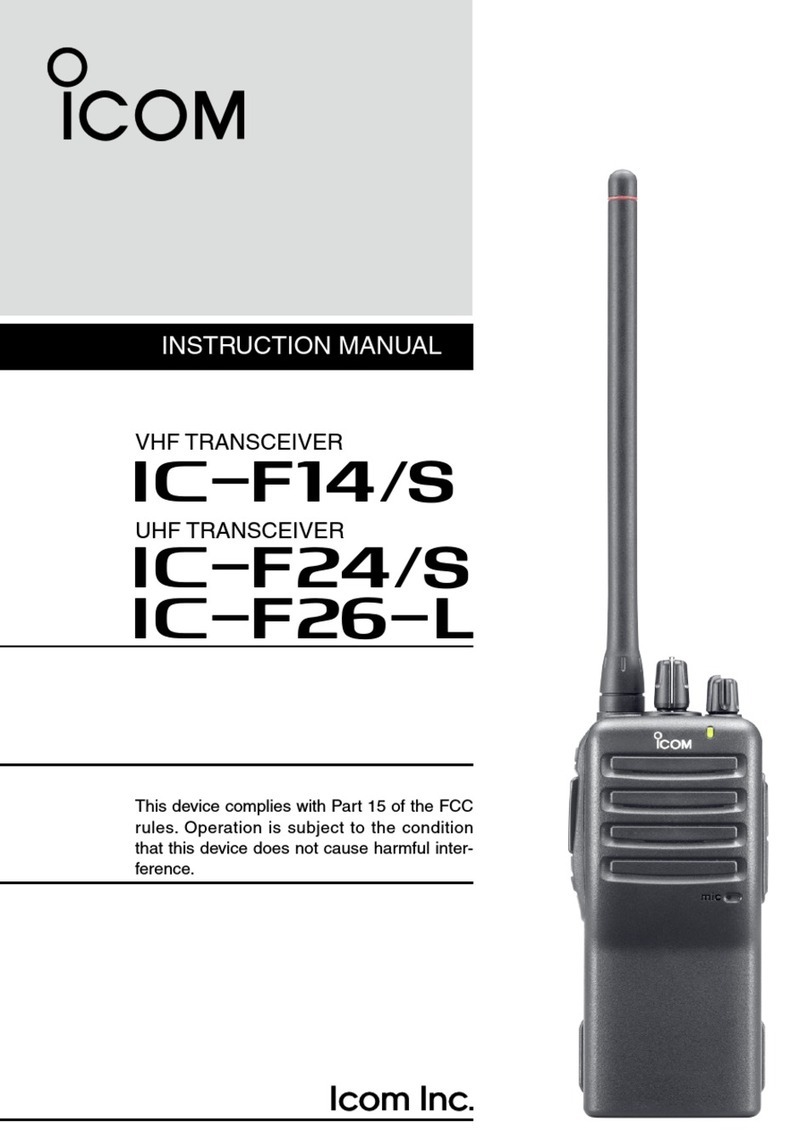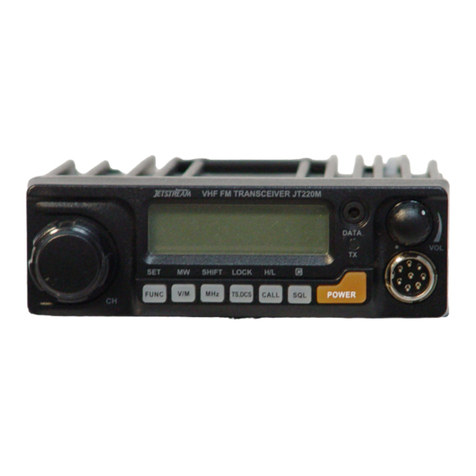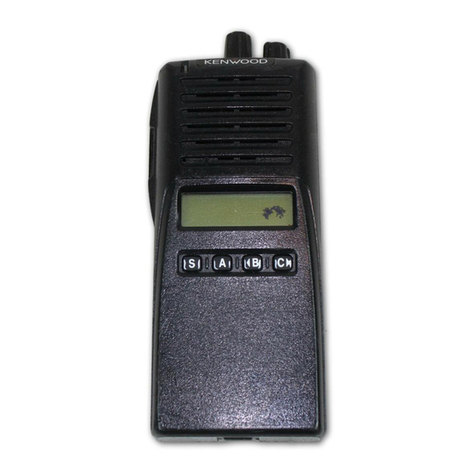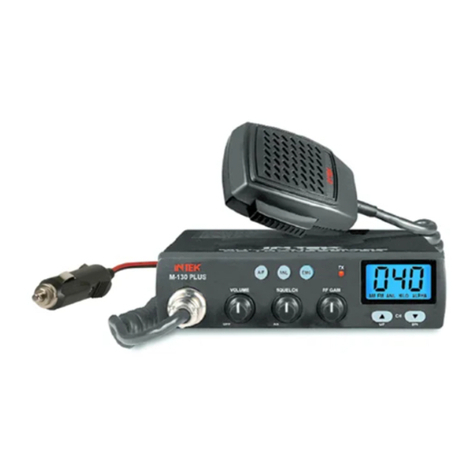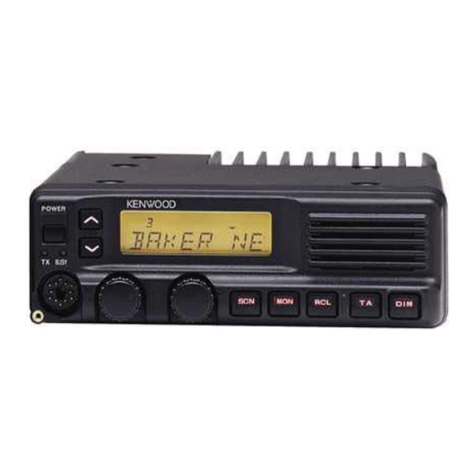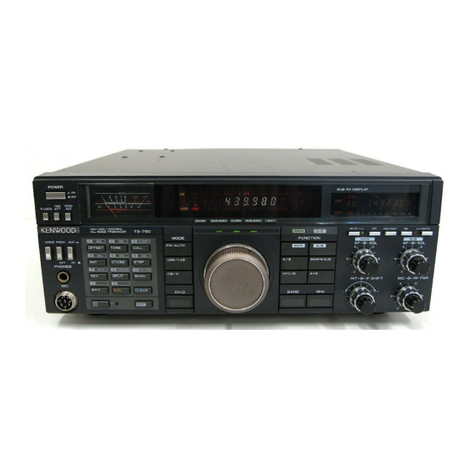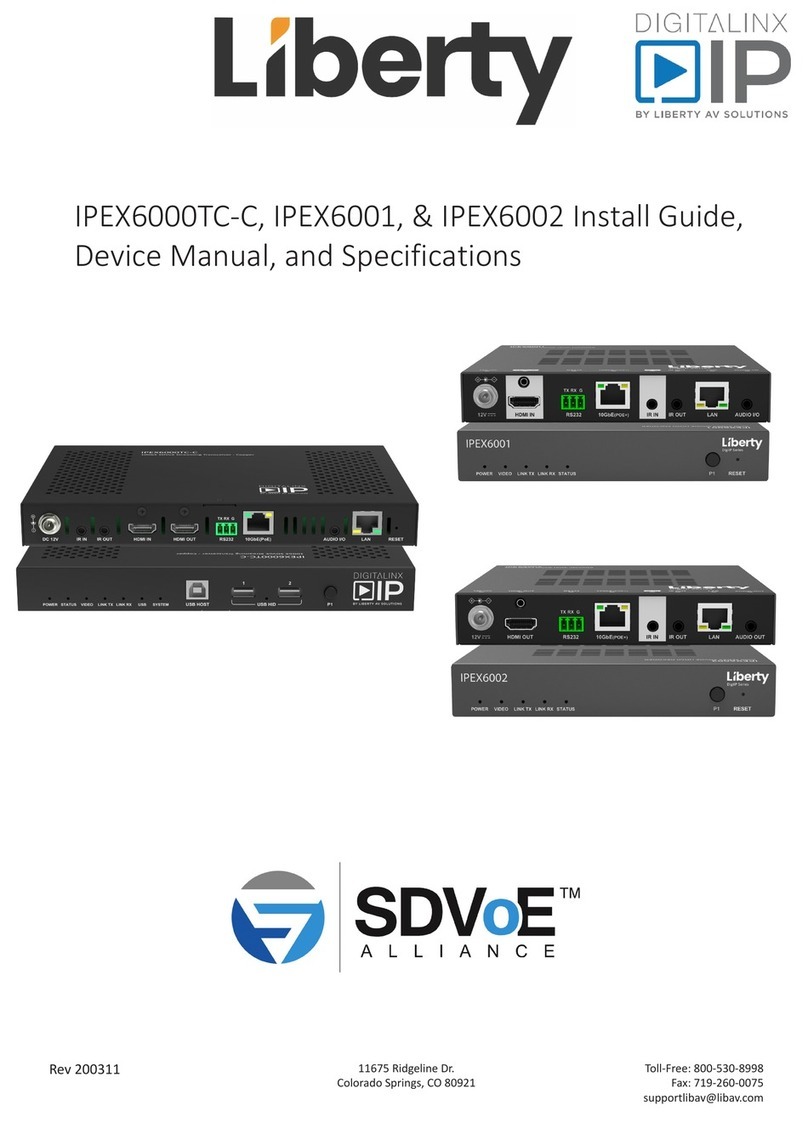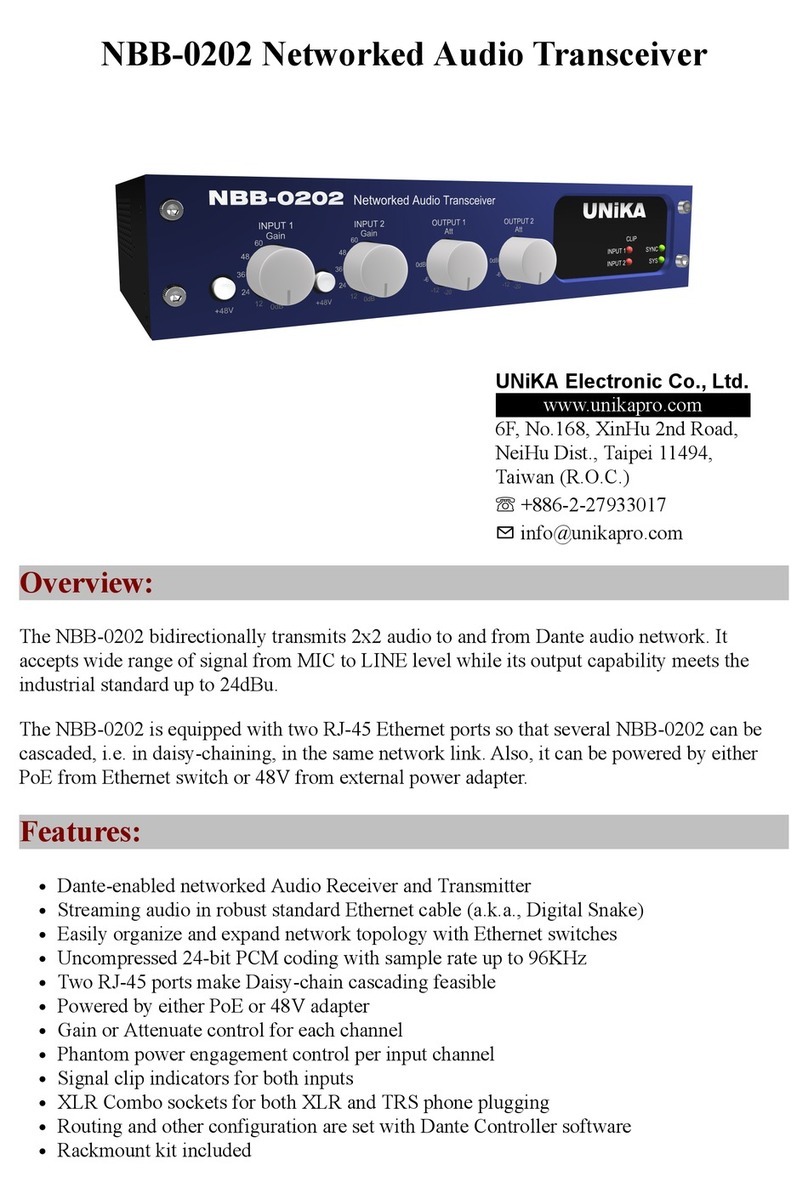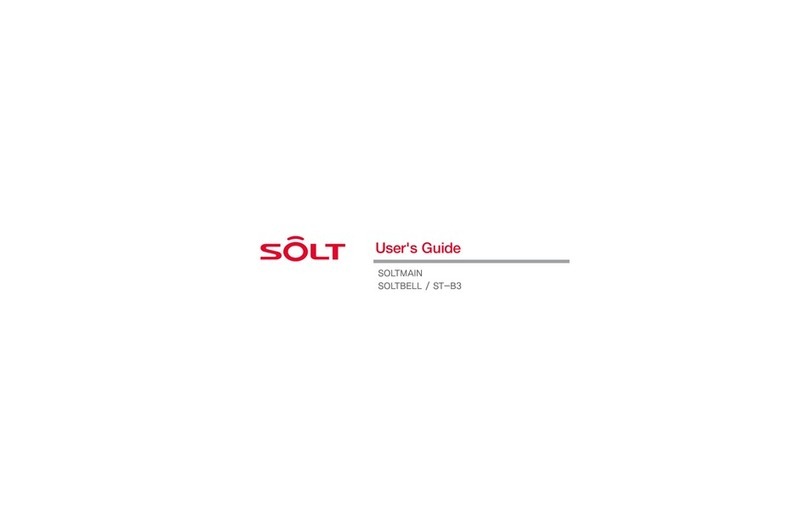Icom IC-M401EURO User manual

INSTRUCTION MANUAL
iM401EURO
VHF MARINE TRANSCEIVER
0 IC-M401EURO_ (2).qxd 01.12.10 11:16 AM Page a (1,1)

If your vessel requires assistance, contact other vessels and
the Coast Guard by sending a distress call on Channel 16.
Or, transmit your distress call using digital selective calling on
Channel 70 (the optional DS-100 (#02) must be installed).
USING DIGITAL SELECTIVE CALLING (ch 70)
(DS-100 DSC CONTROLLER is required)
DISTRESS CALL PROCEDURE
1. Push and hold [DISTRESS] on the DS-100
for 5 sec. until you hear 5 short beeps
change to one long beep.
2. Wait for an acknowledgment from a coast
station.
• Channel 16 is automatically selected.
3. Push and hold [PTT], then transmit the
appropriate information as at left.
USING CHANNEL 16
DISTRESS CALL PROCEDURE
1. “MAYDAY MAYDAY MAYDAY.”
2. “THIS IS ...............” (name of vessel)
3. Your call sign or other indication of the
vessel (AND 9-digit DSC ID if you have one).
4. “LOCATED AT ...............” (your position)
5. The nature of the distress and assistance
required.
6. Any other information which might facilitate
the rescue.
IN CASE OF EMERGENCY
i
Versions of the IC-M401EURO which display the “CE” symbol on the serial number seal, comply with the es-
sential requirements of the European Radio and Telecommunication Terminal Directive 1999/5/EC. òThis warn-
ing symbol indicates that this equipment operates in non-harmonised frequency bands and/or may be subject to
licensing conditions in the country of use. Be sure to check that you have the correct version of this radio or the
correct programming of this radio, to comply with national licensing requirement.
Icom, Icom Inc. and the logo are registered trademarks of Icom Incorporated (Japan) in the United states, the United Kingdom, Germany,
France, Spain, Russia and/or other countries.
0 IC-M401EURO_ (2).qxd 01.12.10 11:16 AM Page b (1,1)

ii
TABLE OF CONTENTS
INSTALLATION NOTES
The installation of this equipment should be
made in such a manner as to respect the EC
recommended electromagnetic field expo-
sure limits (1999/519/EC).
The maximum RF power available from this
device is 25 watts. The antenna should be
installed as high as possible for maximum ef-
ficiency and that this installation height
should be at least 5 meters above ground (or
accessible) level. In the case where an an-
tenna cannot be installed at a reasonable
height, then the transmitter should neither be
continuously operated for long periods if any
person is within 5 meters of the antenna, nor
operated at all if any person is touching the
antenna.
In all cases any possible risk depends on the
transmitter being activated for long periods.
(actual recommendation limits are specified
as an average of 6 minutes) Normally the
transmitter is not active for long periods of
time. Some radio licenses will require that a
timer circuit automatically cuts the transmit-
ter after 1–2 minutes etc.
Similarly some types of transmitter, SSB,
CW, AM, etc. have a lower ‘average’ output
power and the perceived risk is even lower.
1 OPERATING RULES .......................... 1
2 PANEL DESCRIPTION .................. 2 – 4
■ Panel description ............................. 2
■ Function display ............................... 3
■ Microphone ...................................... 4
3 BASIC OPERATION ...................... 6 – 9
■ Channel selection ............................ 6
■ Receiving and transmitting .............. 8
■ Call channel programming ............... 9
■ Memory channel names .................. 9
4 DUALWATCH/TRI-WATCH ......... 10–11
■ Description ..................................... 10
■ Operation ....................................... 10
5 SCAN OPERATION ................... 12 – 13
■ Scan types ..................................... 12
■ Setting tag channels ...................... 13
■ Starting a scan ............................... 13
6 SET MODE ................................. 14 – 15
■ Set mode programming ................. 14
■ Set mode items .............................. 15
7 CONNECTIONS AND
MAINTENANCE ......................... 16 – 20
■ Unpacking ...................................... 16
■ Antenna ......................................... 16
■ Fuse replacement .......................... 16
■ Cleaning ......................................... 16
■ Connections ................................... 17
■ Mounting the transceiver ............... 18
■ Dimensions ..................................... 20
8 TROUBLESHOOTING ...................... 22
9 CHANNEL LIST ................................ 23
10 SPECIFICATIONS AND OPTIONS ... 24
■ Specifications ................................. 24
■ Options .......................................... 24
MB-69 TEMPLATE
0 IC-M401EURO_ (2).qxd 01.12.10 11:16 AM Page c (1,1)

iii
READ ALL INSTRUCTIONS carefully and completely
before using the transceiver.
SAVE THIS INSTRUCTION MANUAL —This in-
struction manual contains important operating instructions for
the IC-M401EURO.
RWARNING! NEVER connect the transceiver to an AC
outlet. This may pose a fire hazard or result in an electric
shock.
NEVER connect the transceiver to a power source of more
than 16 V DC or using reverse polarity. This will ruin the trans-
ceiver.
NEVER cut the DC power cable between the DC plug and
fuse holder. If an incorrect connection is made after cutting,
the transceiver may be damaged.
NEVER place the transceiver where normal operation of the
vessel may be hindered or where it could cause bodily injury.
KEEP the transceiver at least 1 m away from the ship’s nav-
igation compass.
DO NOT use or place the transceiver in areas with temper-
atures below –20°C or above +60°C or, in areas subject to di-
rect sunlight, such as the dashboard.
AVOID the use of chemical agents such as benzine or al-
cohol when cleaning, as they may damage the transceiver
surfaces.
BE CAREFUL! The transceiver rear panel will become
hot when operating continuously for long periods.
Place the transceiver in a secure place to avoid inadvertent
use by children.
After exposure to salt water, clean the transceiver thoroughly
with fresh water to avoid corrosion.
• Do not pour water on the transceiver under the water tap di-
rectly.
CAUTION
IMPORTANT
0 IC-M401EURO_ (2).qxd 01.12.10 11:16 AM Page d (1,1)

1
1
OPERATING RULES
PRIORITIES
•Read all rules and regulations pertaining to priorities and
keep an up-to-date copy handy. Safety and distress calls
take priority over all others.
•You must monitor Channel 16 when you are not operating
on another channel.
•False or fraudulent distress signals are prohibited and pun-
ishable by law.
PRIVACY
•Information overheard but not intended for you cannot law-
fully be used in any way.
• Indecent or profane language is prohibited.
RADIO LICENSES
(1) SHIP STATION LICENSE
You must have a current radio station license before using the
transceiver. It is unlawful to operate a ship station which is not
licensed.
Inquire through your dealer or the appropriate government
agency for a Ship-Radiotelephone license application. This
government-issued license states the call sign which is your
craft’s identification for radio purposes.
(2) OPERATOR’S LICENSE
A Restricted Radiotelephone Operator Permit is the license
most often held by small vessel radio operators when a radio
is not required for safety purposes.
The Restricted Radiotelephone Operator Permit must be
posted or kept with the operator. Only a licensed radio opera-
tor may operate a transceiver.
However, non-licensed individuals may talk over a transceiver
if a licensed operator starts, supervises, ends the call and
makes the necessary log entries.
Keep a copy of the current government rules and regulations
handy.
0 IC-M401EURO_ (2).qxd 01.12.10 11:16 AM Page 1 (1,1)

PANEL DESCRIPTION
2
2
■Panel description
qPOWER/VOLUME CONTROL [VOL]
Turns power ON and OFF and adjusts the audio level. (p. 8)
wSQUELCH CONTROL [SQL]
Sets the squelch threshold level. (p. 8)
eTRANSMIT POWER SWITCH [H/L]
➥Toggles high and low power when pushed. (p. 8)
• Some channels are set to low power only.
➥While pushing this switch, other switches perform sec-
ondary functions.
rCHANNEL/DUALWATCH/TRI-WATCH SWITCH [CH]
➥Exits from Channel 16 or call channel when pushed.
(p. 6)
➥While pushing [H/L], selects channel group when
pushed. (p. 7)
•The European version has International channels only and
this function is not available.
➥Starts dualwatch or tri-watch when pushed for 1 sec.
➥Stops dualwatch/tri-watch when either is activated.
tCHANNEL 16/CALL CHANNEL SWITCH [16]
➥Selects Channel 16 when pushed. (p. 6)
➥Selects call channel when pushed for 1 sec. (p. 6)
•“CALL” appears when call channel is selected.
➥Push for 3 sec. to enter call channel programming con-
dition when call channel is selected. (p. 9)
➥While pushing [H/L], enters memory channel name pro-
gramming condition. (p. 9)
➥Enters set mode when pushed while turning power ON.
(p. 14)
yCHANNEL UP/DOWN SWITCHES [YY]/[ZZ]
➥Push to select the operating channels, set mode con-
tents, etc.
➥While pushing [H/L], push [Y]/[Z] to adjust the bright-
ness of the LCD and switch backlight.
uSCAN SWITCH [SCN] (p. 13)
➥Starts and stops normal or priority scan when tag chan-
nels are programmed.
iTAG CHANNEL SWITCH (p. 13)
➥Push [TAG] to set the displayed channel as a tag
(scanned) channel.
➥While pushing [H/L], push for 3 sec. to clear all tag chan-
nels.
CALL
iC-m401euro
TAG
Speaker Function display qi
ywertu
0 IC-M401EURO_ (2).qxd 01.12.10 11:16 AM Page 2 (1,1)

PANEL DESCRIPTION
3
2
■Function display
qTRANSMIT INDICATOR (p. 8)
“TX”appears while transmitting.
wBUSY INDICATOR (p. 8)
“BUSY”appears when receiving a signal or when the
squelch opens.
eTAG CHANNEL INDICATOR (p. 13)
Appears when a tag channel is selected.
rCALL CHANNEL INDICATOR
“CALL”appears when the call channel is selected. (p. 6)
tLOW POWER INDICATOR (p. 8)
“LOW”appears when low power is selected.
yATIS INDICATOR
➥“ATIS”appears when the ATIS encoder is activated.
•The ATIS encoder is available for Germany and Holland ver-
sions only.
uDUPLEX INDICATOR (p. 7)
Appears when a duplex channel is selected.
iCHANNEL NAME INDICATOR
➥Memory channel name appears if programmed. (p. 9)
➥“”scrolls when the battery voltage drops to
approx. 10 V DC or below.
➥“”appears during dualwatch; “”appears during tri-
watch. (p. 10)
oCHANNEL GROUP INDICATOR (p. 7)
Indicates whether an International (I) or U.S.A (U) channel
is selected.
•USA channel group is available for U.K. and Italy versions only.
!0 CHANNEL NUMBER READOUT
➥Indicates the selected operating channel number.
•“A”appears when a simplex channel is selected. (p. 7)
➥In set mode, indicates the selected condition. (p. 15)
wq
!0
o
e
r
t
y
u
i
0 IC-M401EURO_ (2).qxd 01.12.10 11:16 AM Page 3 (1,1)

PANEL DESCRIPTION
4
2
■Microphone
qPTT SWITCH [PTT]
Push and hold to transmit; release to receive. (p. 8)
wCHANNEL UP/DOWN SWITCHES [YY]/[ZZ]
Push either switch to change the operating memory chan-
nel, set mode contents, etc.
eCHANNEL 16/CALL CHANNEL SWITCH [16/C]
➥Same as the [16] switch on the front panel. (p. 2)
➥Selects Channel 16 when pushed. (p. 6)
➥Selects call channel when pushed for 1 sec. (p. 6)
•“CALL”appears when call channel is selected.
➥Push for 3 sec. to enter call channel programming con-
dition when call channel is selected. (p. 9)
➥While pushing [H/L], enters memory name programming
condition. (p. 9)
•Microphone lock function
The microphone lock function electrically locks the [Y]/[Z]
and [16/C] switches on the microphone. This prevents acci-
dental channel changes and accidental function access.
➥While pushing [16] on the microphone, turn power ON to
toggle the microphone lock function ON and OFF.
Microphone
w
q
e
0 IC-M401EURO_ (2).qxd 01.12.10 11:16 AM Page 4 (1,1)

5
Blank page
0 IC-M401EURO_ (2).qxd 01.12.10 11:16 AM Page 5 (1,1)

6
3BASIC OPERATION
■Channel selection
Channel 16
Channel 16 is the distress and safety channel. It is used for
establishing initial contact with another station and for emer-
gency communications. Channel 16 is monitored during both
dualwatch and tri-watch. While standing by, you must monitor
Channel 16.
➥Push [16] momentarily to select Channel 16.
•Output power turns to “25W”automatically, whenever Channel
16 is selected. For example, when selecting Channel 16 via the
dial, dualwatch/tri-watch or a scan stops at Channel 16, etc.
➥Push [CH] to return to the condition before selecting Channel
16, or push [Y]/[Z] to select an operating channel.
Call channel
Each regular channel group has a separate leisure-use call
channel. The call channel is monitored during tri-watch. The
call channels can be programmed (p. 9) and are used to store
your most often used channels in each channel group for
quick recall.
➥Push [16] for 1 sec. to select the call channel of the se-
lected channel group.
•“CALL”and call channel number appear.
•Each channel group may have an independent call channel after
changing a call channel. (U.K. version only)
➥Push [CH] to return to the condition before selecting call
channel,or push [Y]/[Z] to select an operating channel.
0 IC-M401EURO_ (2).qxd 01.12.10 11:16 AM Page 6 (1,1)

3
BASIC OPERATION
7
International channels
There are 57 International channels for the IC-M401EURO.
qPush [CH] to select a regular channel.
wWhile pushing [H/L], push [CH] to change the channel
group, if necessary.
•“I”appears when International channels are selected.
ePush [Y]/[Z] to select the desired channel.
•“D”appears for duplex channels.
U.S.A. channels (U.K. version only)
For the U.K. and Italy versions, there are 58 U.S.A. channels
in addition to 57 International channels.
qPush [CH] to select a regular channel.
wWhile pushing [H/L], push [CH] to change the channel
group.
•International and U.S.A. channels can be selected in sequence.
ePush [Y]/[Z] to select the desired channel.
•Channels are memorized separately for each channel group.
U
C
I
LOW
DWX ALT
CALL
BUSY
TX
TAG
GPS DSC
POS REPLY
ATIS
U
C
I
LOW
DWX ALT
CALL
BUSY
TX
TAG
GPS DSC
POS REPLY
ATIS
0 IC-M401EURO_ (2).qxd 01.12.10 11:16 AM Page 7 (1,1)

■Receiving and transmitting
CAUTION: Transmitting without an antenna may dam-
age the transceiver.
qTurn [VOL] clockwise to turn power ON.
wSet the audio and squelch levels.
➥Rotate [SQL] fully counterclockwise in advance.
➥Rotate [VOL] to adjust the audio output level.
➥Rotate [SQL] clockwise until the noise disappears.
eWhile pushing [H/L], push [CH] to change the channel
group. (p. 7)
•The European version has International channels only.
rPush [Y]/[Z] to select the desired channel.
•When receiving a signal, “BUSY”appears and audio is emitted
from the speaker.
•Further adjustment of [VOL] may be necessary at this point.
tPush [H/L] to select the output power if necessary.
•“LOW”appears when low power is selected, respectively.
•Choose low power to conserve power, choose high power for
longer distance communications.
•Some channels are for low power only.
yPush and hold [PTT] to transmit, then speak into the mi-
crophone.
•“TX”appears.
•Channel 70 cannot be used for transmission (for GMDSS use).
uRelease [PTT] to receive.
IMPORTANT: To maximize the readability of your trans-
mitted signal, pause a few sec. after pushing [PTT], hold
the microphone 2to 5 cm from your mouth and speak
at a normal voice level.
3BASIC OPERATION
8
0 IC-M401EURO_ (2).qxd 01.12.10 11:16 AM Page 8 (1,1)

3
BASIC OPERATION
9
■Call channel programming
The call channel is used to select Channel 9, however, you
can program your most often-used channels in each channel
group for quick recall.
qWhile pushing [H/L], push [CH] one or more times to se-
lect the desired channel group (International or U.S.A.) to
be programmed. (U.S.A. channel group is available for UK
and Italy versions only.)
wPush [16] for 1 sec. to select the call channel of the se-
lected channel group.
•“CALL”and call channel number appear.
ePush [16] again for 3 sec. (until
long beep changes to 2 short
beeps) to enter call channel pro-
gramming condition.
•Channel number starts flashing.
rPush [Y]/[Z] to select the de-
sired channel.
tPush [16] to program the dis-
played channel as the call chan-
nel.
•Push [CH] to cancel.
•The channel number stops flashing.
■Memory channel names
Memory channels can be tagged with alphanumeric names
of up to 10 characters each.
Capital letters, small letters, numerals, some symbols (! " # $
% & ' ( ) ✱+ ,–.⁄) and spaces can be used.
qSelect the desired memory channel.
•Cancel dual watch, tri-watch or scan in advance.
wWhile pushing [H/L], push [16] to edit memory channel
name.
•A cursor appears and blinks.
eSelect the desired character by pushing [Y]/[Z].
•Push [CH] or [H/L] for cursor movement.
rPush [16] to input and set the name.
•Push [H/L] to cancel.
•The cursor disappears.
tRepeat steps qto rto program other memory channel
names, if desired.
I
CALL
TAG
I
D
CALL
TAG
I
TAG
0 IC-M401EURO_ (2).qxd 01.12.10 11:16 AM Page 9 (1,1)

10
4DUALWATCH/TRI-WATCH
■Description
Dualwatch monitors Channel 16 while you are receiving an-
other channel; tri-watch monitors Channel 16 and the call
channel while receiving another channel.
DUALWATCH/TRI-WATCH SIMULATION
•If a signal is received on Channel 16, dualwatch/tri-watch pauses
on Channel 16 until the signal disappears.
•If a signal is received on the call channel during tri-watch, tri-watch
becomes dualwatch until the signal disappears.
•To transmit on the selected channel during dualwatch/tri-watch, push
and hold [PTT].
■Operation
qSelect the desired operating channel.
wSelect dualwatch or tri-watch in set mode. (p. 15)
ePush [CH] for 1 sec. to start dualwatch or tri-watch.
•“ ” appears during dualwatch; “”appears during tri-watch.
•Beep tone sounds when a signal is received on Channel 16.
rTo cancel dualwatch/tri-watch, push [CH] again.
Dualwatch Tri-watch
Call channel
0 IC-M401EURO_ (2).qxd 01.12.10 11:16 AM Page 10 (1,1)

11
4
DUALWATCH/TRI-WATCH
Operating tri-watch on INT Channel 25Operating dualwatch on INT Channel 25
Dualwatch starts.
I
D
TAG
Signal received on
Channel 16 takes
priority.
I
D
BUSY
TAG
Dualwatch resumes
after the signal
disappears.
I
D
TAG
Tri-watch starts.
Signal is received on
call channel.
Tri-watch becomes
dualwatch and monitors
Channel 16 while
receiving signal.
Signal received on
Channel 16 takes
priority.
Tri-watch resumes
after the signal
disappears.
I
D
TAG
I
D
BUSY
TAG
I
CALL
BUSY
TAG
I
D
TAG
[Example]
0 IC-M401EURO_ (2).qxd 01.12.10 11:16 AM Page 11 (1,1)

12
■Scan types
Scanning is an efficient way to locate signals quickly over a
wide frequency range. The transceiver has priority scan and
normal scan.
Set the tag channels (scanned channel) before scanning.
Clear the tag channels which inconveniently stop scanning,
such as channels used for digital communication.
Choose priority or normal scan in set mode. (p. 15)
NORMAL SCAN
Normal scan, like priority scan, searches through all tag
channels in sequence. However, unlike priority scan, Chan-
nel 16 is not checked unless Channel 16 is set as a tag
channel.
CH 01 CH 02
CH 06
CH 05 CH 04
CH 03
5SCAN OPERATION
PRIORITY SCAN
Priority scan searches through all tag channels in se-
quence while monitoring Channel 16. When a signal is de-
tected on Channel 16, scan pauses until the signal disap-
pears; when a signal is detected on a channel other than
Channel 16, scan becomes dualwatch until the signal dis-
appears.
CH 06
CH 01
CH 16
CH 02
CH 05 CH 04
CH 03
0 IC-M401EURO_ (2).qxd 01.12.10 11:16 AM Page 12 (1,1)

■Setting tag channels
For more efficient scanning, add desired channels as tag
channels or clear tag channels for unwanted channels. Chan-
nels set as non-tag channels will be skipped during scanning.
Tag channels can be assigned to each channel group inde-
pendently.
qWhile pushing [H/L], push [CH] one or more times, select
the desired channel group, if desired. (U.S.A. channel
group is available for UK and Italy versions only.)
wSelect the desired channel to set as a tag channel.
ePush [TAG] to set the displayed channel as a tag channel.
•“TAG”appears in the function display.
rTo cancel the tag channel setting, repeat e.
•“TAG”disappears.
•Clearing all tag channels in the selected channel group
➥While pushing [H/L], push [TAG] for 3 sec. to clear all tag
channels in the channel group.
■Starting a scan
Set scan type (priority or normal scan) and scan resume timer
in advance using set mode. (p. 15)
qSet tag channels as described at left.
wWhile pushing [H/L], push [CH] one or more times, select
the desired channel group, if desired. (U.S.A. channel
group is available for UK and Italy versions only.)
ePush [SCN] to start priority or normal scan.
•“SC 16”or “SCAN”appears in the function display.
•When a signal is detected, scan pauses until the signal disap-
pears or resumes after pausing 5 sec., according to set mode
setting. (Channel 16 is still monitored during priority scan.)
•Push [Y]/[Z] to check the scanning tag channels, to change the
scanning direction or resume the scan manually.
•“16”flashes and a beep tone sounds when a signal is received
on Channel 16 during priority scan.
rTo stop the scan, push [SCN].
•“SC 16”or “SCAN”disappears.
5
SCAN OPERATION
13
Scan starts. When a signal is received
I
D
TAG
I
D
TAG
I
D
BUSY
TAG
[Example]: Starting a priority scan.
Push [SCN]
0 IC-M401EURO_ (2).qxd 01.12.10 11:16 AM Page 13 (1,1)

6SET MODE
14
■Set mode programming
Set mode is used to change the conditions of some of the
transceiver’s functions.
NOTE: Available functions may differ depending on dealer
setting.
Entering set mode
qTurn power OFF.
wWhile pushing [16], turn power ON to enter set mode.
eAfter the display appears, release [16].
rPush [16] to select the desired item, if necessary.
tPush [Y]/[Z] to select the desired condition of the item.
yTurn power OFF, then ON again to exit set mode.
Scan mode Scan resume timer Dual/tri watch
LCD contrast Beep tone
Push
•SET MODE CONSTRUCTION
0 IC-M401EURO_ (2).qxd 01.12.10 11:16 AM Page 14 (1,1)

6
SET MODE
15
■Set mode items
Scan mode
The scan mode can be selected as a normal scan or priority
scan. (p. 12)
Scan resume timer
The scan resume timer can be selected as a pause (OFF) or
timer scan (ON). When OFF is selected, the scan pauses until
the signal disappears. When ON is selected, the scan pauses 5
sec. and resumes even if a signal is being received on chan-
nels except for Channel 16.
Dualwatch/tri-watch
This item can be selected as dualwatch or tri-watch. (p. 10)
Beep tone
You can select silent operation by turning beep tones OFF, or
you can have confirmation beeps sound at the push of a
switch by turning beep tones ON.
LCD contrast
This item adjusts the contrast of
the LCD in 4 steps.
Normal scan
Priority scan (default)
Scan timer OFF (default) Scan timer ON
Dual watch (default) Tri-watch
LCD contrast 3 (default)
Beep tone ON (default) Beep tone OFF
0 IC-M401EURO_ (2).qxd 01.12.10 11:16 AM Page 15 (1,1)

16
7CONNECTIONS AND MAINTENANCE
■Unpacking
The following accessories are supplied: Qty.
qMounting bracket ............................................................ 1
wDC power cable (OPC-891) ........................................... 1
eMicrophone hanger ........................................................ 1
rMicrophone hanger cable*
(OPC-1096 : Black or OPC-1097 : White) ...................... 1
tMounting bracket knobs ................................................. 2
yMicrophone hanger screws (3 ×16 mm) ......................... 2
uMounting screws (5 ×20 mm) ......................................... 2
iFlat washers (M5) ........................................................... 2
oSpring washers (M5) ...................................................... 2
*Depending on version.
■Antenna
A key element in the performance of any communication sys-
tem is an antenna. Ask your dealer about antennas and the
best places to mount them.
■Fuse replacement
Two fuses are installed in the supplied DC power cable. If a
fuse blows or the transceiver stops functioning, track down
the source of the problem if possible, and replace the dam-
aged fuse with a new, rated one.
■Cleaning
If the transceiver becomes dusty or dirty, wipe it clean with a
soft, dry cloth.
AVOID the use of solvents such as benzene or al-
cohol, as they may damage transceiver surfaces.
qe
wr
t
y
u
i
o
0 IC-M401EURO_ (2).qxd 01.12.10 11:16 AM Page 16 (1,1)
Other manuals for IC-M401EURO
1
Table of contents
Other Icom Transceiver manuals
